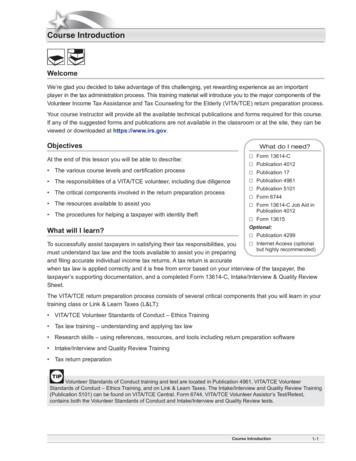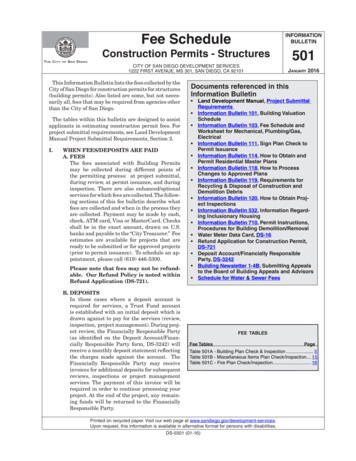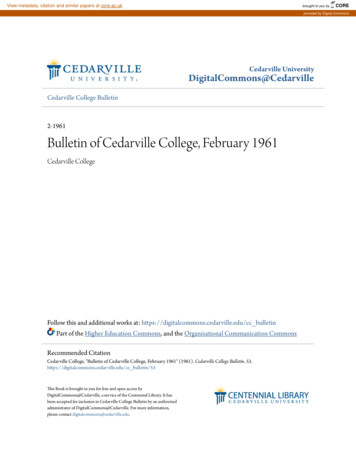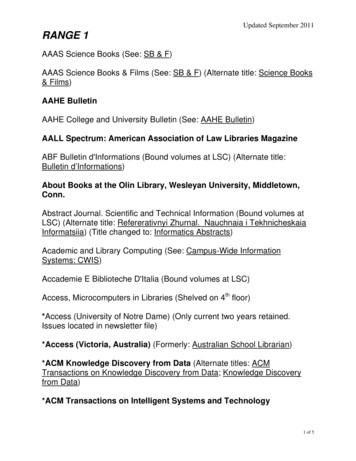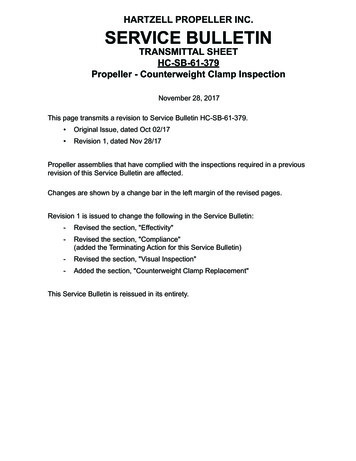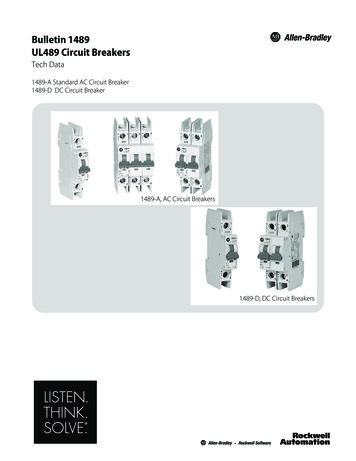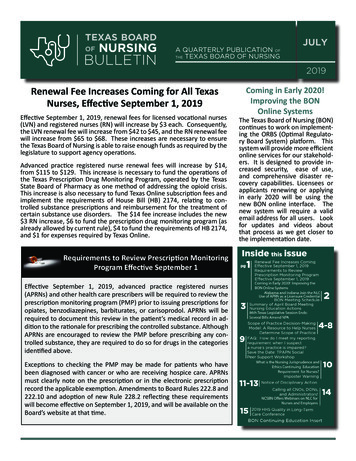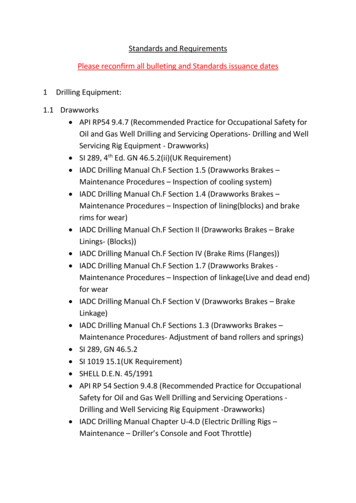
Transcription
Captive Insurance TeamTo: Our Clients and FriendsSeptember 2013Captive Insurance Companies in Europe – TheBenefits of Internal Risk CoverageCaptive Insurance Companies (or in short “Captives”) are intra-group insurance companies. They insurerisks of their affiliates resulting from their business operations instead of transferring them to the1insurance market.Today there are over 5,000 Captives worldwide with US headquartered enterprises in the lead. Over60% of the Fortune 500 have established Captives. But Captives are not only for the largeconglomerates. A Captive can also be suitable for a smaller or medium sized company, depending onthe specific risk profile.A big advantage of Captives is that they can insure risks that cannot be insured in the direct insurancemarket (e.g. deductibles), or not at a reasonable price. Captives can also capture underwriting profitand investment income typically retained by commercial insurers. Further, through their access to thereinsurance market, Captives can potentially obtain more favorable premium rates and other terms andconditions compared to commercial insurance coverage. Thus, Captives can help save premiums whichover time may considerably exceed their administration costs. They can not only be used for the classicproperty & casualty risk coverage, but also for losses resulting from product liability, extendedwarranty, environmental contamination, credit default, un(der)funded pension schemes, andcompliance. In parallel, Captives can improve internal risk management by centralizing profit and lossinformation relating to a company’s risk management programs and reinforcing the benefits of lossprevention and similar risk management tools.In this Client Alert we will summarize the main drivers for, and key considerations to be made prior to,setting up a Captive.1Note: Captives can, in theory, also insure third party risks. In this Client Alert we only talk about so-called “Pure Captives”,which exclusively insure group internal risks, since a discussion of the use of Captives to insure third party risks is beyond thescope of this Client Alert.This Client Bulletin is published for the clients and friends of Bryan Cave LLP. Information contained herein is not to be considered as legal advice.This Client Bulletin may be construed as an advertisement or solicitation. 2013 Bryan Cave LLP. All Rights Reserved.Bryan Cave LLPAmerica Asia Europewww.bryancave.com
Types of CaptivesCaptives can be structured to directly write insurance for company group members or as a reinsurancecompany. Captives set up as reinsurance companies typically use a commercial fronting insurer to issuethe respective policy to the group members and then reinsure the risk with the Captive; the premiumspaid by the group members will be passed through as ceded reinsurance premium less a certainfronting fee. The Captive itself can further reinsure the risk in the reinsurance market (so-called“retrocession”), potentially at more favorable premium rates.International groups further have the choice of domicile. Captives incorporated in the same jurisdictionas the parent company are so-called “Domestic Captives”; in turn, if the seat is abroad, they are called“Offshore Captives”. The best jurisdiction for a Captive depends on various considerations: theregulatory framework, accounting requirements, tax benefits, political aspects and legal stability,capital requirements and currency exchange risks.Advantages of CaptivesCaptives can help reduce insurance costs significantly over time. But monetary benefits are, by far, notthe only driver for setting up a Captive. Captives can help to materially improve internal riskmanagement and compliance. Besides, Captives can insure risks for which coverage may not beavailable in the commercial market (at all or at a reasonable price). In more detail: Flexibility; Improved Risk Management and Compliance: The Captive’s insurance policies can beadapted to the specific risk profile of the group and the group’s individual objectives and businessstrategy. The awareness about the interplay of risk management, a low claims rate and lowinsurance premiums usually results in a positive risk selection. In addition, the internal handling ofthe claim, but by a different entity, can help avoid moral hazard and improve group widecompliance. Improved insurance costs: If properly designed and when used within the context of a riskmanagement strategy that emphasizes risk retention, a Captive can provide significant savings tothe group’s overall insurance program costs. Accrual ability, Tax advantage, Cash Management: If properly structured, the Captive can build taxdeductible reserves for the insured risks and the operating companies can deduct the insurancepremiums paid – unlike Captives, operating entities cannot accrue reserves for uninsured risks.Depending on the respective tax situation of the individual group members and applicable taxtreaties, this can result in tax benefits. In addition, depending on the regulatory requirements, theCaptive can use the excess funds for optimizing the group’s cash management. Balance sheet protection: If a risk materializes, the balance sheets of the operating entities areprotected since the loss is borne by the Captive. For that purposes it is imperative that the Captiveis properly capitalized and/or reinsured. Coverage of uninsured risks: For many risks which are business specific or new or have aparticularly bad risk profile (high potential losses or high probability) there is often no coverageavailable in the open market or at least not for a reasonable premium. Since a Captive underwritesBryan Cave LLPAmerica Asia Europewww.bryancave.com
only the risks of its corporate group, it can calculate the underlying risks based on its ownexperience and provide insurance coverage for premiums appropriate to the group. Access to reinsurance market: Captives can directly access the reinsurance market and, thus,potentially achieve better insurance terms than operating entities in the commercial market. Thegroup can become less dependent on the commercial insurance market and achieve additionalflexibility as a result. Transparency: Providing insurance through a Captive often leads to a better understanding andfocus on risk management and the claims history of the group, potentially leading to a significantreduction of the company’s overall cost of risk. At the same time the calculation of the premiumsbecomes more transparent. Low running costs: Captives can save on overall insurance costs by capturing underwriting profitthat is built into the premiums of commercial insurers. There are different options available,including Rent-a-Captive models. Virtually all administrative and management functions of theCaptive can be efficiently outsourced to third party service providers. Insurance technical profits are retained: If the Captive has underwriting profits (in particular inyears with no/low claims or through successful investments) they remain within the group and notwith the third party insurer. They can either be carried forward, or, subject to regulatoryapprovals, can be advanced as inter-company loans, or be distributed to the parent company. No price fluctuations or risk of extra-ordinary termination after claim: While insurance premiumsare often subject to material up- and down turns, Captives can help to stabilize premiums (subjectto the Captive being properly capitalized and meeting applicable regulatory requirements).Further, there is no need for annual renegotiations or the threat of termination when risksmaterialize or a certain accumulation of claims occur.So in general, there are many reasons which support the formation of a Captive. However, one mustnot forget that the Captive is an insurance company and must be solvent enough to bear the insuredrisks if and when they materialize, or have sufficient reinsurance coverage. Further, if only the “good”risks are covered internally this may result in higher third party premiums for the “bad” risks. Also,Captives have to comply with applicable insurance laws, including capitalization and reserverequirements. The regulatory requirements are subject to change, as are the applicable tax laws, so2that envisaged future profits may be smaller when collected than anticipated originally. But theexisting Captives show that the pros often outweigh the cons if structured and managed properly.2For example, the Solvency II regulation (2009/138) may result in substantial changes for insurance companies, includingpotentially capital requirements for Captives.Bryan Cave LLPAmerica Asia Europewww.bryancave.com
Addressable Risks3Captives can insure most of the known risks and group specific risks. Typical risks covered include: Deductibles P&C Risks Contractors All Risk Credit Default Fidelity Product Liability Extended Warranty Business Interruption Employee Benefits and Pensions Schemes Punitive Damages (where permitted) M&A Liabilities Surety (Performance or Warranty Bonds) Litigation or investigation expense, including compliance penalties (to the extend permitted)Suitable candidates for CaptivesThe range of businesses that are suitable for Captive structures is as broad as the spread of insurablerisks and the strategies pursued with self-insurance concepts. In general, the use of a Captive should beconsidered for entities that have the required liquidity to capitalize the Captive (depending on thetype, structure, domicile, and risk profile, but based on the EU regulation 2005/68/EG a minimum ofEUR 1 million for reinsurance Captives) and meet one or more of the following criteria: Minimum annual premium: If the goal is to reduce general insurance premiums through access tothe reinsurance market and exercise of available tax benefits, the business should have a certainminimum annual premium (approx. EUR 1 million) and a positive claims history. Proper deductibleswill help support a sustainable calculation. Functioning risk management: Companies that have or are willing to adopt good risk managementpractices or that want to have more control over claims handling and other aspects critical to theirrisk management programs. Restricted insurance market access: Companies that are unable to obtain adequate insurance in thecommercial market or Companies that have better-than-average loss experience but are hindered3Limitations may come from other directions, like the compliance department. It is questionable if good corporate governanceallows a Captive to insure certain D&O risks like willful wrongdoing of the board members or employees.Bryan Cave LLPAmerica Asia Europewww.bryancave.com
by other factors (e.g. structural complexity) that inhibit efficient access to commercial insurancemarkets or the ability to obtain stabilized insurance pricing.Forming or participating in any type of captive insurance company involves significant legal, tax andrisk management issues and requires consideration of each company’s unique situation and objectives.Bryan Cave’s Captive Insurance Team regularly assists clients with the design, formation and licensingof captive insurance companies, and advises on corporate, regulatory and tax aspects of captiveinsurance companies. Clients of Bryan Cave’s Captive Insurance Team include Fortune 500 companies,national associations and privately held businesses.For questions or further information, please speak to your regular Bryan Cave contact, a memberof our Captive Insurance Team, or the authors of this client alert:Veit DenzerStefan SkuleschKevin FischerFrankfurtFrankfurtSt. Louis 49 69 509 514 1103 49 69 509 514 1105 1 314 259 cave.comkevin.fischer@bryancave.comBryan Cave's alerts/bulletins/briefings are available online at www.bryancave.com/bulletins.This bulletin is published for the clients and friends of Bryan Cave LLP. To stop this bulletin or all futurecommercial e-mail from Bryan Cave LLP, please reply to: meika.willmot@bryancave.com and either specify whichbulletin you would like to stop receiving or leave the message blank to stop all future commercial e-mail fromBryan Cave LLP. Information contained herein is not to be considered as legal advice. Under the ethics rules ofcertain bar associations, this bulletin may be construed as an advertisement or solicitation.Bryan Cave LLPAmerica Asia Europewww.bryancave.com
insurance companies. Clients of Bryan Cave's Captive Insurance Team include Fortune 500 companies, national associations and privately held businesses. For questions or further information, please speak to your regular Bryan Cave contact, a member of our Captive Insurance Team, or the authors of this client alert: Veit Denzer Frankfurt
